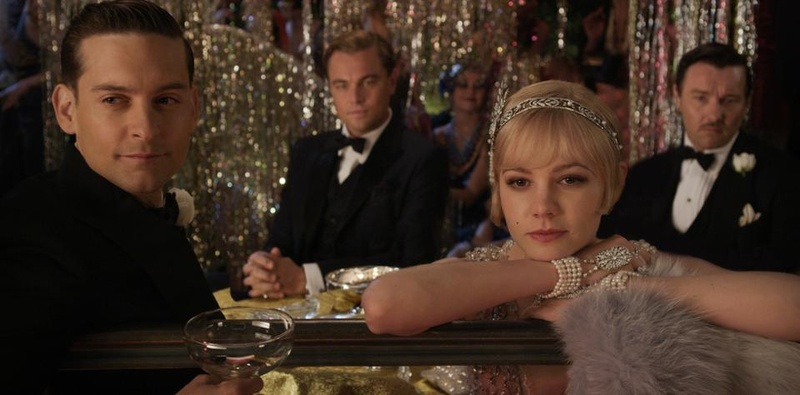People are going to make fun of Baz Luhrmann’s “The Great Gatsby.” The movie—which is the fifth film adaptation of F. Scott Fitzgerald’s classic novel—is almost pure spectacle, with tinsel, bare legs, champagne fountains, and, of course, fast cars dominating nearly every frame of the two-and-a-half-hour event. Luhrmann’s piece seems constantly aware of its own decadence, compounding extravagance with extravagance as the film continues to its crescendo. In fact, the film is packed so full of confetti and sex that there seems to be little room for one key element: the source text. This makes for an entertaining film, perhaps, but not for a successful adaptation of one of the great American novels.
The earliest and most egregious misstep in the film is the rewriting of Nick Carraway’s story. We find him in the winter after the summer of Gatsby, staring ponderously out of snow-frosted windows, speaking even more ponderously about his binge-drinking habits and general sense of malaise. It becomes clear that he is being treated at some sort of swanky sanatorium—taking time to decompress from all he witnessed. This setup leads to his doctor telling him to write it all down, even if no one will read what he produces. It is difficult to parse whether this order is based on a premonition that the ensuing book will be a great work of literature, or on a deep and utterly understandable desire to stop listening to Tobey Maguire’s listless narration as Carraway. On the occasions when the film does directly quote the novel, the timbre of Maguire’s voice has a kind of grating insistence to it that does considerable damage to Fitzgerald’s original prose. In fact, the novel seems largely at odds with the film, something not at all mitigated by the uncomfortably heavy-handed insertion of floating text during especially poignant moments, the letters of which dissolve into snowflakes more often than not.
It’s not all bad, though. In fact, it’s often dazzling and affecting, especially during the more intimate moments of character development. Carey Mulligan’s Daisy feels slightly too human for the role, rarely reaching the heights of cold vapidity that the character does in the book. However, her chemistry with both her husband Tom (Joel Edgerton) and of course Gatsby (Leonardo DiCaprio), is easily the cause of some of the best moments in the film. The infamously ambiguous shirt scene between Daisy and Gatsby has a resonance to it that transcends melodrama, and the final scenes between Daisy and Tom have almost palpable force thrumming beneath them.
The choice of DiCaprio for Gatsby feels almost too easy: the middle-aged star is easily the most bankable of available options for the tricky-to-cast role. However, though the choice seemed inevitable, DiCaprio certainly gives it his best effort. He truly shines in the moments when Gatsby is off-balance or vulnerable, seeming manic with the possibility of defeat, while always maintaining an iron sense of control. His characterization of Gatsby is not necessarily moving, but then again, Gatsby is not a pitiful character, and DiCaprio’s performance is true to this, erring on the side of giving the character distance instead of revealing him at his basest state.
The strong acting—though it holds the film together—is far from the focal point of the piece. The camera work seems committed in many parts of the film to turning debauchery and murder into a theme-park ride. The pans back and forth between the East and West Egg neighborhoods are unnerving and even nauseating in 3D as the camera skims the surface of the water. The party scenes at Gatsby’s are astonishing, replete with fireworks and mechanical Charleston dance moves.
The real problem at the core of the movie seems to be restraint: Luhrmann has none. When the aesthetics that marked the early party scenes carry over to the final, gory moments of the film, they feel plastic and hurried. There is no moment when the story breaks open to reveal its rotten core—even a concluding funeral scene has an impenetrable gloss over it. It seems apparent that Luhrmann is entranced with the first half of the story but confounded by the finale, and the film stumbles as it tries to explain why we should care about all this in the first place. While entertaining and visually magnificent, “The Great Gatsby” misses it mark for the sequins in its eyes.
—Staff writer Sorrel L. Nielsen can be reached at sorrelwestbrook-nielsen@college.harvard.edu
Read more in Arts
Take a Break! DIY EditionRecommended Articles
-
Paglia Opines on American Culture, DiCaprio, Evils of PostmodernismCamille Paglia, diva to aesthetes, gave her trademark stream-of-consciousness commentary on life, art and academia last night to a packed
-
The DepartedThe Departed Directed by Martin Scorsese Warner Bros. Pictures 5 stars Martin Scorsese returns to his old tricks in “The
-
Top Literary Characters and Their Harvard CaricaturesCharacter: Jay Gatsby—“The Great Gatsby” by F. Scott Fitzgerald Caricature: Finals Club Guy An ostentatious social climber with a penchant
-
Off the BooksNobody reads anymore. It’s not that we’re illiterate. We’re just un-booked.
-
 A.R.T.'s 'Gatz' Takes Classic Tale to Stage in Novel Adaptation
A.R.T.'s 'Gatz' Takes Classic Tale to Stage in Novel Adaptation -
Reader Redux: Identifying With Gatsby In Love and StressAaron Aceves explains how "The Great Gatsby" has elicited different emotions from him as he ages.














